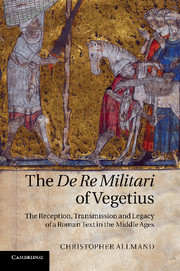 The De Re Militari of Vegetius
The De Re Militari of Vegetius Book contents
- Frontmatter
- Contents
- Figures
- Preface
- Abbreviations
- Introduction
- Part I The medieval reception
- Part II The transmission
- Part III The legacy: the De re militari in medieval military thought and practice
- 11 The development of Vegetian influence
- Appendix I Table of select terms used in translations of the De re militari
- Appendix II List of manuscripts of the De re militari
- Bibliography
- Index
- References
11 - The development of Vegetian influence
from Part III - The legacy: the De re militari in medieval military thought and practice
Published online by Cambridge University Press: 07 October 2011
- Frontmatter
- Contents
- Figures
- Preface
- Abbreviations
- Introduction
- Part I The medieval reception
- Part II The transmission
- Part III The legacy: the De re militari in medieval military thought and practice
- 11 The development of Vegetian influence
- Appendix I Table of select terms used in translations of the De re militari
- Appendix II List of manuscripts of the De re militari
- Bibliography
- Index
- References
Summary
Introduction
The transmission of ideas expressed by Vegetius, ideas which, on his admission, were not necessarily his own, was achieved through the use of the written word: the copying of his text, whether in whole or in parts (excerpts); the making of translations; and, most interesting of all, the way his ideas were reflected in those of others as they discussed matters of war, government, even religious practice. Many types of people, soldiers, rulers, even clergy, were to have an interest in what Vegetius had written.
It is one thing to see ideas proposed by or attributed to Vegetius reflected in written works. It is quite another, and a much more difficult one to pinpoint or to analyse, to say precisely how such ideas either influenced or, at least, came to be reflected in military or other forms of action. In brief, what practical influence did the teachings of the man called ‘el sabio’ or ‘der meister’ have upon the way war was conducted in the Middle Ages? Although we can say that the De re militari had influence at an intellectual level, how far did that influence extend to the way things were actually done? While ‘the hope that Roman warfare could be studied and then imitated was a common simplification among humanists’, was Vegetius’ legacy in any sense practical?
- Type
- Chapter
- Information
- The De Re Militari of VegetiusThe Reception, Transmission and Legacy of a Roman Text in the Middle Ages, pp. 251 - 348Publisher: Cambridge University PressPrint publication year: 2011


